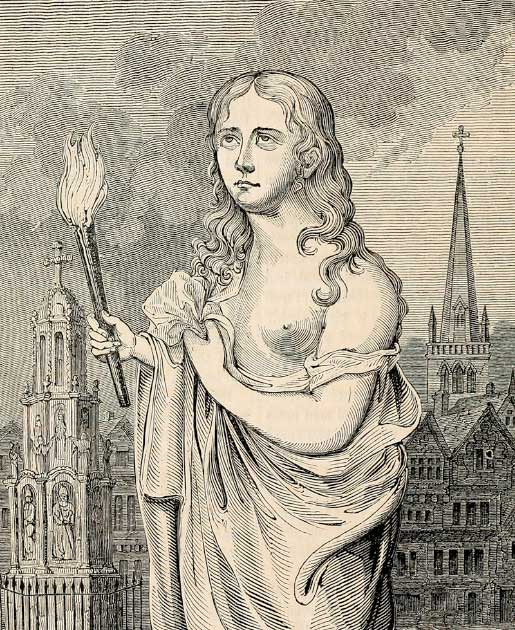
Royal Mistress Jane Shore Walked Streets of London in her Underwear
Elizabeth "Jane" Shore was a fiery and charismatic Englishwoman who made a name for herself as one of the many sultry mistresses of the handsome and powerful English king, Edward IV. With her undeniable charm and influence, Jane Shore was one of the king’s favorites, holding a firm grip on the king's heart and using her power to defend and aid those who found themselves in his crosshairs.
Following the death of Edward IV, however, Jane Shore’s fortunes quickly took a turn for the worse. She was accused of bring a harlot by Richard III and forced to walk through the streets of London in her underwear. She lived to tell the tale, surviving until the ripe old age of 82.

Print portrait of Jane Shore: “Give gentle mistress Shore one gentle kiss the more” (Shakespeare, Richard III, Act 3, scene 1). (Public domain)
The Early Life of the Formidable Jane Shore
Living between the 15th and 16th centuries, Jane Shore, born as Elizabeth Lambert, was a London native born to privilege in 1445. As the daughter of wealthy merchant, John Lambert and his wife Amy, Jane was lavished with a top-notch education and hobnobbed with England's elite society.
- Powerful Female Figures of Britain: The Real Life Women of ‘The Favourite’
- Intelligence and Witchcraft – What Caused the Downfall of Anne Boleyn?
Her intelligence and beauty quickly attracted many admirers, but her father was determined to secure a suitable match for his daughter. He arranged for her to marry a goldsmith named William Shore. Known for his good looks and financial success, he was 15 years her senior.
Sadly, the union was doomed from the start, devoid of the fiery passion and affection for which Jane later became known. She was granted an annulment in 1476 by Pope Sixtus IV due to her husband's impotence and inability to perform his marital duties. This fearless woman was not one to be held back by societal constraints and forged ahead, making her mark on history.

Portrait of King Edward IV, the notorious ladies’ man who kept Jane Shore as his mistress until his death. (Public domain)
Jane Shore: A Trailblazer Who Used Her Power for the Greater Good
Jane met King Edward IV the same year her annulment was granted. Having caught his eye, she became his coveted mistress. Despite Edward IV's reputation as a notorious ladies' man, Jane held a special place in his heart and remained by his side until his untimely death.
The king himself praised Jane for her vivacious personality and quick wit, describing her as “Merry in company, ready and quick of answer,” and over time Jane Shore came to hold a significant amount of sway over him.
Jane used her considerable influence to help other and to fight for the rights of those who had fallen out of favor with the king. Time and again she emerged victorious in securing pardons for the unjustly accused. Though her exact role in court politics remains a mystery, it is unlikely that she played a major role in court affairs of the time. Nevertheless, she did use her power for the benefit of others.

Portrait of Jane Shore. (Public domain)
After Edward IV’s Death Jane Shore Attempted to Forge Allegiances
When the king passed away in 1483, Jane Shore tried to maintain her place at the English court by becoming the mistress of Thomas Grey. Grey was the son of Elizabeth Woodville, Edward IV's queen, and her first husband Sir John Grey of Groby.
Jane also had the support and protection of another lover, Lord Hastings. Hastings was a close friend and advisor of the king, as well as being Jane's most famous admirer before her marriage to William Shore. Thanks to her relationships, Jane helped bring the Woodvilles and the Hastings together in an alliance that was seen as a threat by Richard III, the younger brother of Edward IV.
To understand why Richard III would have felt this way, it’s necessary to look at his actions after Edward IV’s death in April 1483 when he was named Lord Protector for his 12-year-old nephew Edward V. In a shameful chain of events, in 1484 he had the marriage of the womanizing Edward IV to Elizabeth Woodville declared invalid under the Titulus Regius act.
The result was that their children were declared illegitimate and thus unable to take the throne. Edward V and his brother Richard have been remembered as the Princes in the Tower and are presumed to have been murdered when they were imprisoned by their uncle in the Tower of London. Historians assume they were murdered before Richard III ascended to the throne.
Fueled by fear and paranoia, Richard III accused Lord Hastings of treason and had him promptly executed. The Woodvilles were not spared either, with Elizabeth facing witchcraft allegations, although no further action was taken. Tragically, several of Elizabeth's relatives, including one of her brothers, were not as lucky and they were executed under orders from Richard III.

The public penance of Jane Shore, who was forced to walk through the streets of London in her underwear, by William Blake. (Sailko / CC BY 3.0)
Jane Shore and her Infamous Walk of Shame
As the person responsible for bringing the Hastings and Woodvilles together, Jane was also a target for the ruthless King Richard III. Although she too was accused of witchcraft, there was not enough evidence to convict her of this crime and she was charged with harlotry (sexual immorality or prostitution).
At St. Paul's Cathedral, Elizabeth "Jane" Shore received the customary sentence for harlotry, which required her to perform public penance. Jane walked through the streets of London barefoot, dressed only in her kirtle (an outer petticoat) and carrying a taper (a kind of candle).
- The Princes and Heroes Behind Shakespeare’s Hamlet, The Mad Prince Who Murdered His Uncle to Avenge His Father
- Whipping Boys Were Kids Spanked in Place of an ‘Untouchable’ Young Prince
Despite her circumstances, witnesses were moved by Jane's dignity during the walk of shame. While the ordeal was intended to humiliate her, it may have done the opposite. Some historians claim that this act contributed to Richard’s reputation as a cruel and unjust ruler. Her public penance is thought to have inspired the Walk of Atonement in the television series Game of Thrones.
Jane was sent to Ludgate Prison following her public penance. While imprisoned, Thomas Lynom, the King's Solicitor, became infatuated with her and proposed marriage. Despite Richard's objections, Lynom persisted and eventually obtained a pardon for Jane from the king.
Despite rumors that Jane Shore died in poverty, it is unlikely to be true as her husband was relatively wealthy, and she would have enjoyed a comfortable life. In her later years, Jane met Sir Thomas More, who wrote about her in his History of King Richard the Third. Around 1527 Jane died at the age of 82 and was buried in Hinxworth Church in Hertfordshire.
Top image: Detail from theatre poster for Jane Shore at Royal Princess' Theatre in Edinburgh, December 1885. Source: Public domain
By Wu Mingren
















Comments
In the Medieval Monarchy, blatant self-interest ruled in the name of national interest. But times have changed. National interest has been replaced by global interest in the excuses stakes. So that's all good then...